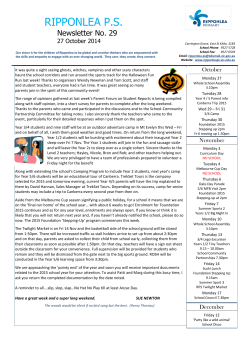
Semantic Representations via Multilingual Sentence Equivalence
Semantic Representations via Multilingual Sentence Equivalence Chu-Cheng Lin Kazuya Kawakami Language Technologies Institute, Carnegie Mellon University Introduction Results Cross lingual document classification Recently many research have been done in word semantics. In particular, distributed word representation gathers a lot of attention. However we still don’t know what is a proper way of representing a sentence. I In this project, we want to investigate into distributed representations that are constrained by the principle of semantic equivalence. I We build on the CVM model (Hermann and Blunsom, 2013) and extend the model for multilingual semantic equivalence. I We evaluate our sentence embeddings on a cross–lingual document classification task. I Also, we used cross lingual sentence embeddings for reranking translation candidates, we get marginally better results on a small test set. I CVM The CVM model just adds individual word embeddings to get the sentence embeddings. I We want to make ve accord with vf . I Specifically, we use this loss function: 0 00 0 00 cost(ve, vf , v , v ) = 2 log(dist(ve, vf ))−log(dist(ve, v ))−log(dist(vf , v )), (1) 0 00 where v and v are embeddings of sentences that are known to be different from ve and vf . He ate Sushi EN I He Sushi il a FR DE Figure: CVM mangé ... Er aß Sushi glove embeddings I random vectors We use Europarl except for Chinese throughout the experiments. For each language we use 100000 translation pairs. Optimization is done with AdaDelta. Figure: RCV1/RCV2 Task Description init strategy (de) +en +fr + en +fi + en +cs + en +zh + en +fr + cs + en random 0.436 — 0.467 — 0.467 — 0.661 0.664 0.673 0.676 0.614 0.685 glove Table: Results from CVMs on the CLDC task. First we train a German–English MT system with MOSES and obtain features f1 . . . fN and associated weights w1 . . . wN . I We add a new feature ds,c , the Euclidean distance of translation candidate ec to the source sentence s. I Fixing w1 . . . wN , we search for optimal weight wd that maximizes BLEU on the test set. I Results are in Tab 2. I ② Rerank Eucladian Distance He ate Train Test Reranking translation candidates Metric original score reranked score BLEU METEOR TER 32.7 51.5 51.8 32.8 51.4 51.6 Table: Results from reranking Discussion Language pair: adding Finnish, Czech and French helps accuracy. But adding initialized Chinese actually hurts accuracy. However the best results are obtained from a run with both French and Czech. I Loss function: standard hinge loss doesn’t do well. I Initializing with GloVe embeddings helps a lot. However adding extra uninitialized languages help. I The quality of word embeddings obtained from CVM models are not suitable for word similarity tasks (WS-353 dataset). I Ich esse Sushi Er aß Sushi Sushi ① MOSES k-best outputs References aß Sushi Perceptron Figure: Reranking Task Er ate I Multilinguality Multilingual Data will add information such as I Grammatical Difference I Synonym / Antonym I Wordsense Disambiguation (e.g. bank is translated to ”banque” or ”rive”) Cross Lingual Document Classicication Task (RCV1/RCV) Train Classifier with German sentence vector, and Test with English sentence vector. We evaluate our CVM sentence embeddings on a German-English cross-lingual document classification task. In this task we train a perceptron classifier using sentence embeddings of German texts, and classify test English documents. We want to know I how much does multilinguality help: we test with these language settings: (de, en), (de, fr , en), (de, fi, en), (de, cs, en), (de, zh, en) I if initialization with existing monolingual embeddings help: we compare between two initialization strategies K. Hermann and P. Blunsom Multilingual distributed representations without word alignment. arXiv preprint arXiv:1312.6173, 2013. Future Work We tried LSTM for sequence to sequence translation models but they suffered high perplexity. Probably performance can be improved with more data. I In the future we hope to generate sentences from these learned sentence embeddings. I
© Copyright 2025













